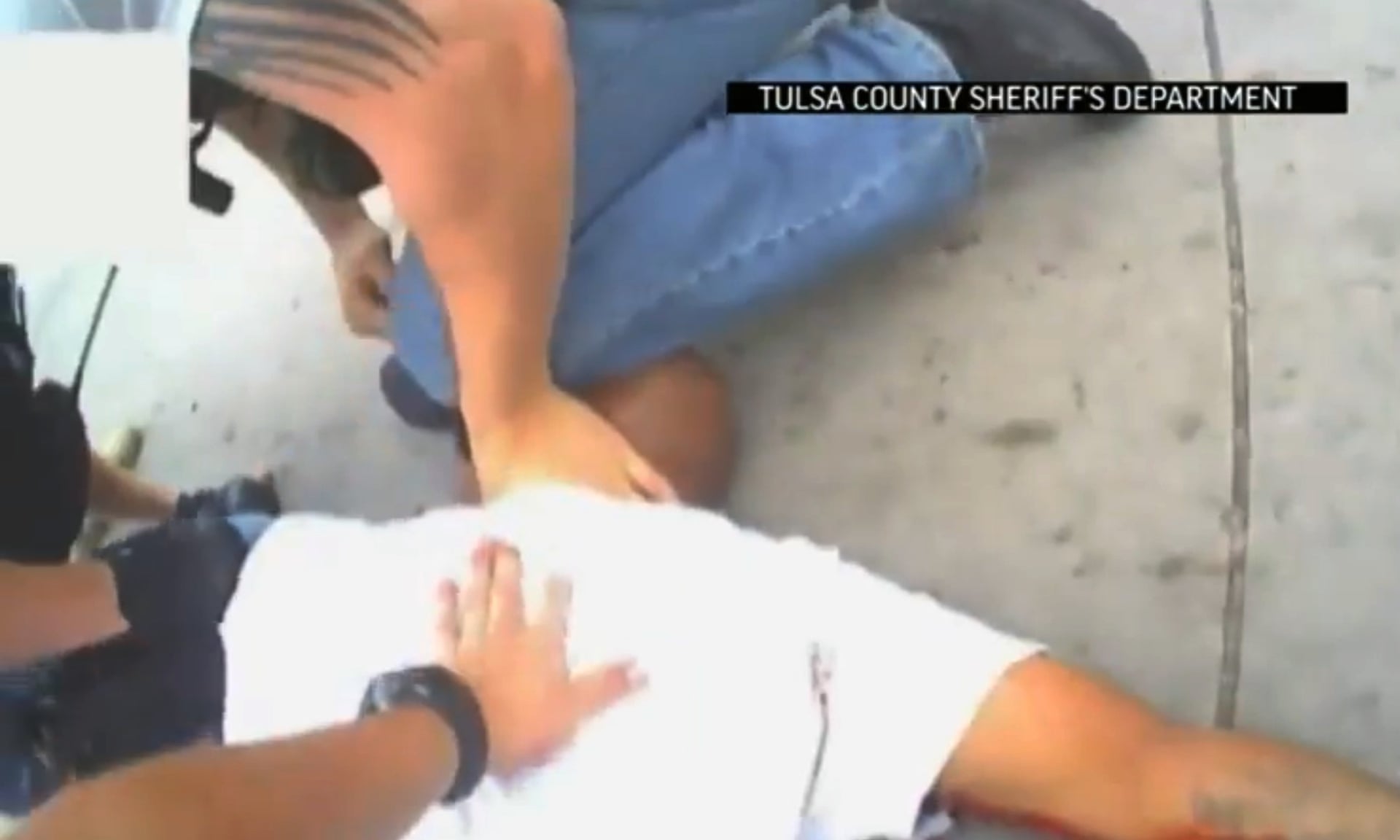
Eric Harris was shot by a 73-year-old reserve deputy who said he thought he was using his stun gun instead of his service weapon when he opened fire: photo by AP via The Guardian, 13 April 2015
Oklahoma officer charged in killing of black man after Taser 'mistake:' Sheriff’s office found fatal shooting of Eric Harris by deputy Bob Bates was ‘a mistake’ but family says: ‘This is simply evil’: Tom Dart, The Guardian, 13 April 2015
A 73-year-old insurance salesman and reserve sheriff’s deputy has been charged with second-degree manslaughter after he appeared to accidentally fire his gun instead of his Taser and shot dead an unarmed man, Eric Harris.
Harris, 44, died on 2 April after a sting operation designed to catch him selling a gun went wrong. He fled on foot but was caught and wrestled to the ground.
In video released by the Tulsa County sheriff’s office, the deputy, Bob Bates, yells “Taser”, then a shot is heard and he says: “I shot him, I’m sorry.”
A gun is visible on the ground next to Harris, who cries out in pain: “Oh God, he shot me, I didn’t do shit.”
WOW. RT @deray: in his hand: type of gun that killed #EricHarris -- on table: gun type sheriffs lied & said was used: image via Coach Kitty @CameraOnAmazon, 13 April 2015
On
Monday the district attorney, Steve Kunzweiler, told the Guardian the
sheriff’s office had provided him with the findings of its investigation
on Friday afternoon.
In filing the charges on Monday, he said: “Oklahoma law defines
culpable negligence as ‘the omission to do something which a reasonably
careful person would do, or the lack of the usual ordinary care and
caution in the performance of an act usually and ordinarily exercised by
a person under similar circumstances and conditions.”
Harris’
brother, Andre Harris, told reporters at a news conference on Monday
that officers from the sheriff’s department tried to discourage him from
hiring an attorney.
He said he did not believe the shooting was “a racial thing. I don’t
think this has anything to do with race. It might have a hint there
somewhere. … This is simply evil.”
“When
you’re the law, I guess you feel like you can do things and get away
with it and not get exposed. Well, we’ve come to expose it. We’ve come
to pull a mask off the evil.”
Bates,
a wealthy insurance executive in the Oklahoma city, was named
the department’s reserve deputy of the year in 2011. He worked for the
Tulsa police department for a year in the mid-1960s and is one of 130
volunteer reserves in the sheriff’s department, according to Tulsa
World, which said he had donated equipment as well as $2,500 to the
re-election campaign for sheriff Stanley Glanz in 2012.
Did the 73-year-old man who shot and killed #EricHarris pay to be a cop in his spare time?: image via CNN International @cnni, 13 April 2015
Glanz, 72, told Tulsa World he had not given his friend and fishing companion special treatment and
that the sheriff’s office once had an 81-year-old deputy. Bates simply
“made an error”, Glanz said. “How many errors are made in an operating
room every week?”
On Sunday, the Harris family issued a statement which said they “do
not believe it is reasonable for a 73-year-old insurance executive to be
involved in a dangerous undercover sting operation” and added: “We do
not believe it is reasonable -- or responsible -- for [the sheriff’s
office] to accept gifts from a wealthy citizen who wants to be [a] ‘pay
to play’ cop.”
History lives in the present. Never forget that fact. America's slave patrol police. #ericharris #walterscott: image via chauncey devega @chaunceydevega, 11 April 2015
In the video of events in Tulsa, which came from a police body
camera, officers continue to try to subdue Harris, one shouting: “Shut
the fuck up ... You ran, motherfucker, do you hear me, you fucking ran.”
When the 44-year-old says “I’m losing my breath,” an officer replies: “Fuck your breath.”
kneeling on his head, left hand grabbing neck, right hand clenched ready to punch #ericharris #firstaid: image via Mike Spangenberg @MikeSpangenberg, 11 April 2015
I
am a Black woman with asthma. I cannot even engage with "f--k your
breath" as something that one human being says to another human.
-- tweet via Ebony Elizabeth @Ebonyteach, 13 April 2015
The unimaginable cruelty of a world where a cop says "f*ck your breath" as you lay dying. Have mercy, God.
-- tweet via Yolanda Pierce @YNPierce, 13 April 2015
Hollow.
I don't have words for #EricHarris. My words won't form. His last words
- and his murderers' vile answers - keep ringing in my ear.
-- tweet via Ava DuVernay @AVAETC, 13 April 2015
-- tweet via Ava DuVernay @AVAETC, 13 April 2015
There's
not much more barbaric than continuing to physically/mentally terrorize
someone as they lay dying, screaming in fear. #Eric Harris
-- tweet via Jesse Benn @JesseBenn, 13 April 2015
-- tweet via Jesse Benn @JesseBenn, 13 April 2015
"F*ck your breath" is the experience.
-- tweet via StLNYC @StLnNYC, 13 April 2015
Westworld – Onde Ninguém Tem Alma | Retrospectiva #Westworld #MichaelCrichton: image via A Fábrica @Fabdeexpressos, 9 March 2015
Harris died in hospital.
In their statement, Harris’s family said: “Perhaps the most
disturbing aspect of all this is the inhumane and malicious treatment of
Eric after he was shot ... No human being deserves to be treated with
such contempt. These deputies treated Eric as less than human. They
treated Eric as if his life had no value.”
At a press conference last Friday, the Tulsa sheriff’s office said
its own investigation had concluded that Bates had made a mistake and
had not committed a crime. It brought in a Tulsa police sergeant, Jim
Clark, as a private consultant.
Tulsa Police Sgt. Jim Clark (right),
acting as an independent consultant for the Tulsa County Sheriff's
Office, and Sheriff's Capt. Billy McKelvey listen to a question during a
press conference about the shooting death of a suspect by a reserve
deputy: photo by Cory Young/Tulsa World, 11 April 2015
Clark told reporters that Bates was “a true victim of ‘slips and
capture’”, a term used to describe a mistake when someone thinks he or
she is taking one course of action but is following another.
It
was an argument used by former Oakland police officer Johannes Mehserle
to explain why he shot dead Oscar Grant at a Bart station in 2009 when,
Mehserle said, he had planned to use his Taser.
Mehserle was convicted of involuntary manslaughter. The incident inspired the 2013 film Fruitvale Station.

Oscar Grant,
shortly before being fatally shot by San Francisco Bay Area Rapid
Transit officer Johannes Mehserle, New Years Day, 2009: photo by
Associated Press
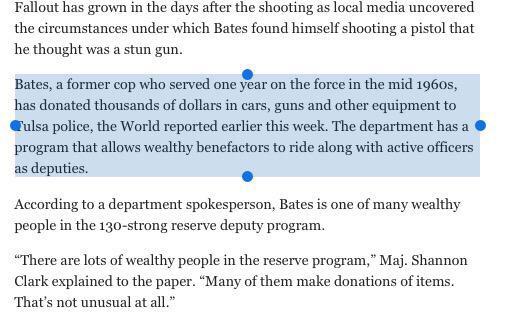
The deputy that shot and killed #EricHarris is an insurance executive who pays to play cop: image via AlexMedina @mrmedina. 13 April 2015
After the K.K.K. take off their hoods they go back to being your police, prosecutors and judges
#EricHarris #firstaid: image via Frank Clark @menes676, 11 April 2015
#MichaelCrichton Writer Series continues with #Westworld (1973): image via Motion State Review @motion_state, 8 April 2015
You are afforded the right to remain silent. #WalterScott #EricHarris: image via BlackHistoryStudies @BlkHistStudies, 13 April 2015
Steven W. Thrasher: Oklahoma and "Bad" History
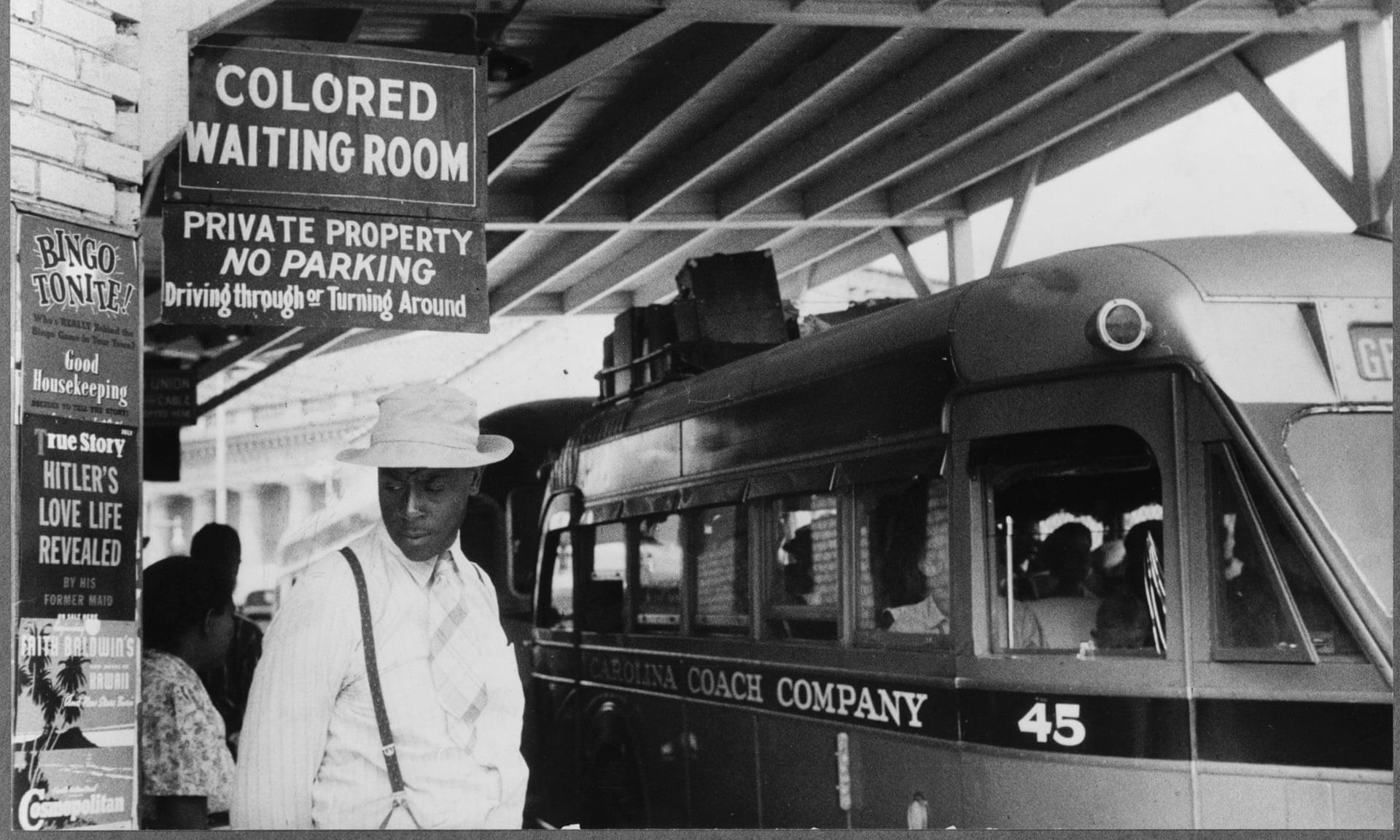
If history teachers banished lessons on “bad” American history, what would be left?: photo by PhotoQuest via The Guardian, 19 February 2015
Sorry, Oklahoma. You don't get to ban history you don't like: Going after history classes that don’t teach “American Exceptionalism” is anything but patriotic: Steven W. Thrasher, The Guardian, 19 February 2015
Oklahoma
House Republicans on the Common Education Committee voted on Tuesday to
ban advanced placement US history courses, because they think [such
courses show] "what is bad about America". If I were Oklahoma, I’d want
to forget about “what is bad about” American history, too, especially in
my corner of it!
In
its “good” history, Oklahoma can boast being the basis of Rodgers and
Hammerstein musical and the home of Oral Roberts University.
But if Oklahomans were to purge all their local stories which reflect
“what is bad about America”, their history pages would be wiped as white
as a Tulsa klansman’s hood. Oklahoma was the extremely violent home to a
number of lynched African-Americans, as chronicled by America's Black
Holocaust Museum; the Native American men, women and children
slaughtered at what is now the Washita Battlefield National Historic
Site;
and the white people who killed them and likely went to church that
very week. It is where Timothy McVeigh committed the largest domestic
act of terrorism in recent years and blew up, killed and wounded
hundreds of people in the Alfred P Murrah Federal Building. Oklahoma is
chock full of former reservations
where Native Americans were forced to relocate. It’s where, just last
year, a botched execution took 45 minutes and left condemned Clayton
Lockett "a bloody mess". And it’s where the violent fracking of its
natural resources may be the reason why Oklahoma has gone from having
“one or two perceptible earthquakes a year” to “averaging two or three a
day.”
Just
last month, Education Week gave the state a D- on education and ranked
it 48th in the nation. Clearly, Oklahoma could move up from being third
dumbest, fourth most incarcerated, and sixth fattest state if it just
ignored its unpleasant history, right?
Nationally,
if history teachers were to banish everything “bad” about America from
our classrooms (i.e., the three-fifths compromise, Jim Crow, the lack of
women’s suffrage for a century and a half, the genocide of Native
Americans, the annexation of Mexico through war, the sexual assault of
one in three women in her lifetime, the apartheid of imprisoned African
Americans, Ronald Reagan, the internment of Japanese Americans,
McDonald's, the colonization of Puerto Rico, the Chinese Exclusion Act,
exporting chemical warfare, Three Mile Island, Applebee's [without
drones], TGIF’s [with drones], killing kids with drones, selling drones
to foreign countries, and Ryan Secrest,
to name just a few national disasters), and to instead only teach about
what was truly exceptional about America, what would be left to give
lessons on?
Who knew THIS SHIT could be topped by #FuckYourBreath: image via Steven Thrasher@hrasherxy, 13 April 2015
National
Republicans seem to agree with what the Okies are doing
here: when it comes to focusing too much on “bad” history (ie, not
propagating white superiority or creationism enough), Oklahoma
Republicans are in good company. Republicans in Arizona have already
banned ethnic studies in public schools. Wisconsin governor Scott Walker
wants to burnish his White House creds by cutting $300 mn from his
public university system.
Louisiana Republican Governor Bobby Jindal is also eyeing 2016 by
trying to gut $300 mn from his public university system, but from a
state which “has already cut more money, on a per-student basis, from
higher education than almost any other state in the country.”
National
Republicans aren’t any better: they blocked Democratic Senator
Elizabeth Warren’s bill to lend [money to] college students at the same
interest banks get. Senator Marco Rubio currently opposes President
Obama's plan to make community college free
because he says it doesn’t give “options” and will make the poor feel
“pressured to attend community college” just “because it’s the one
option paid for by the government.”
This
latest anti-education effort, which will only punish really
smart kids (who are the ones who want to earn college history credits
while in a high school AP course) came about because Republicans think
the coursework doesn’t shill for “American exceptionalism” enough. But
why would Oklahoma Republicans -- who embrace education "options" --
want to rob all of their brightest high school seniors of the choice
to inexpensively earn college history credits just because their history
lessons may be critical and not necessarily full of pro-American
propaganda?
If
America is exceptional for anything, it was exceptional for the
process its founders set in motion at the moment of its birth, when they
put their plans into the tangible words of the Constitution. It was an
imperfect document to be sure (that "three-fifths thing”, for example),
but words were a vastly improved repository for nationhood than a crown.
That Constitution gave us the impetus to place both our nation and
our history -- wretched and glorious alike – in writing, in a document
which could be amended, but would never be erased. We write shit down
and improve on it: that is the American exception. The written word
records our history, all of our history, in a way oral history alone can
not, especially not with the centuries-long holocaust of Americans of color.
Republicans’ efforts -- in Oklahoma
and otherwise -- to bury the past and replace it with a prettier version
are outright un-American -- in addition to being 100% ahistorical.
Holding our children’s futures hostage by refusing them the opportunity
to learn both the good and the bad is simply an effort to secure future
votes, not help children learn ... and you can’t hide the truth from
kids forever, as any parent who welcomed Santa Claus into their home
knows all too well.
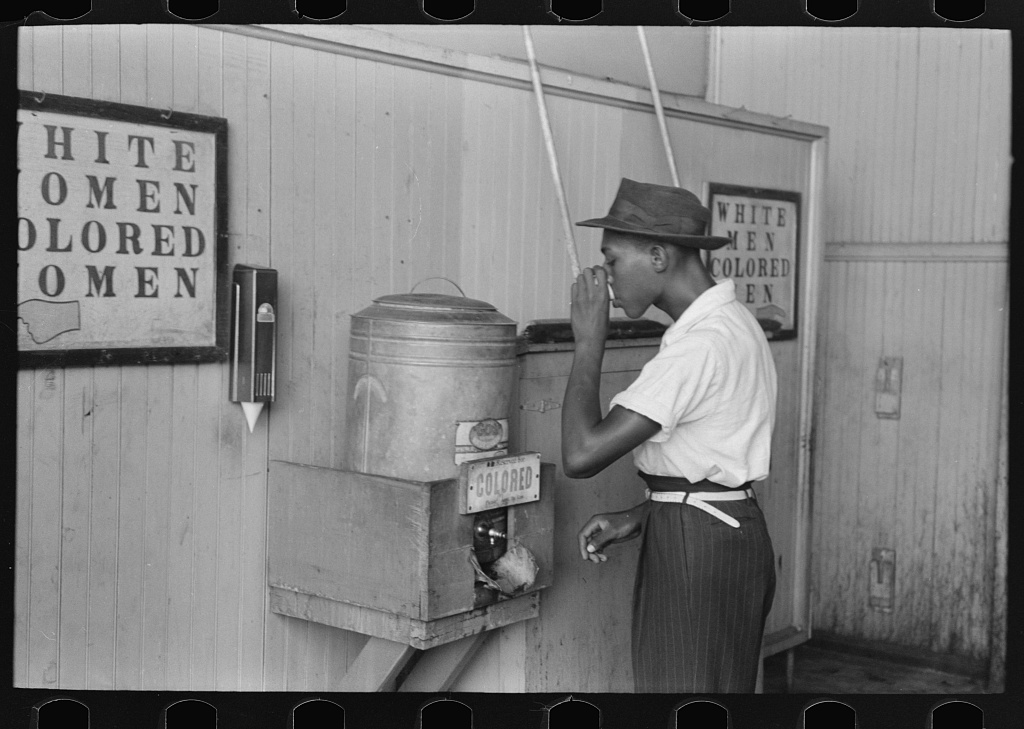
Negro drinking at "Colored" water cooler in streetcar terminal, Oklahoma City, Oklahoma: photo by Russell Lee, July 1939 (Farm Security Administration Collection, Library of Congress)
Unappeased: The 1921 Tulsa race riot: "It really destroyed my faith in humanity"

Olivia
Hooker, 99, is one of the last survivors of the 1921 Tulsa
Race Riot. While her family home survived the destruction, the family
lost everything else they had -– including her father’s department store. Hooker,
who was only 6 at the time of the
riot, had never experienced racism before the mobsters burned down
Greenwood. After she witnessed white Tulsans loot her town, her
perceptions of race were dramatically altered: "It really destroyed my
faith in humanity". After 93 years of fighting for restitution, Hooker
admits it is not likely she’ll ever receive anything: photo by Al Jazeera America, 19 July 2014
Survivors
of infamous 1921 Tulsa race riot still hope for justice: Witness to the
destruction of their world, they are dying before reparations can reach
them: Dexter Mullins, AlJazeera America, 19 July 2014

The Greenwood neighborhood of Tulsa, Oklahoma, after the 1921 Tulsa race riot: photo courtesy of Tulsa Historical Society via Al Jazeera America, 19 July 2014
It was only a 1-square-mile area on the north side of Tulsa, but for
blacks in the 1900s, Greenwood was everything the South was not. Filled
with black lawyers, doctors and business owners, flush with prosperity,
here was an area where African-Americans finally had a chance to make
something of themselves, escaping the harsh racism of a nation that
deprived them of even the most basic dignities.
A dollar would circulate 19 times before leaving Greenwood, a
byproduct of the segregation laws, which kept blacks from shopping
anywhere else but also united the community financially. There was
affluence and education in Greenwood not seen anywhere else in the
country for African-Americans, and each day more people were coming to
carve out a piece of the dream for themselves, adding to the prosperity
of the neighborhood.

African-Americans taken prisoner during the riot. An armed white man rides on the running board of the truck: photo courtesy of Tulsa Historical Society via Al Jazeera America, 19 July 2014
This was the town Olivia Hooker was born in, the place she called
home as a little girl, an African-American child oblivious to the racism
plaguing the country until the day in 1921 when all of her neighborhood
would be wiped off the map in the space of a day: the bank, the elegant
brick homes, the Red Wing Hotel, Mann’s Grocery, the Dreamland Theatre,
even her father’s department store, the Sam D. Hooker Store at 124
Greenwood Avenue.
On May 30, 1921, a young black man was accused of assaulting a white
woman. That accusation was the tipping point for a town already reeling
from racial tension, and would turn into the worst 24 hours in the
city’s history, known as the Tulsa Race Riot.
Hooker is 99 now, a retired teacher living in White Plains, New York.
But when the riot happened, she was 6, exposed for the first time to
the brutal realities of discrimination and hatred. She was devastated.
“And so when this terrible thing happened, it really destroyed my
faith in humanity,” she said. “And it took a good long while for me to
get over it.”
There are fewer than a dozen survivors of the riot, which Hooker
refers to as “the catastrophe.” And for nearly a century now, the
survivors have been seeking reparations for the destruction of their
homes and businesses. Despite their best efforts, they have come up
empty-handed.
Experts and historians may have differing accounts of what happened,
but they all agree on one thing: It’s likely that the survivors will die
before they receive what they are seeking.

Thousands of families were left homeless from the fire that raged through the 35 blocks of Greenwood during the riot: photo courtesy of Tulsa Historical Society via Al Jazeera America, 19 July 2014
Tulsa wasn’t the first city to experience a race riot, and it would
not be the last. Racial disturbances were commonplace at the time, as
the nation struggled to grapple with its rapidly changing culture.
During the "Red Summer of 1919," there were more than two dozen race riots across the country. In
Chicago, tensions mounted over housing, job prospects and which race had
use of certain recreational areas, resulting in a bloody riot.
Washington, D.C., experienced its own unrest after a white woman
fabricated a story of being raped by two black men, a common lie of the
time that was then inflamed by the white press, kicking off yet another
riot.
There were similar eruptions in Knoxville, Tennessee, and Omaha,
Nebraska, that summer. And even after Tulsa, a rape accusation was the
cause of a riot in Rosewood, a black community in Florida that was
burned to the ground in 1923. In Tulsa, it all started because of an incident between Dick Rowland,
a black man, and Sarah Page, a young white woman, in an elevator at the
Drexel Building. It’s not exactly clear what the chain of events was --
even the state’s official report lists a variety of stories surrounding
what happened -- but most credible accounts agree on the basic facts.
On May 30, 19-year-old Rowland was riding in an elevator operated by 17-year-old Page. Rowland
tripped as he was exiting the elevator and grabbed Page’s arm in an
attempt to steady himself. She screamed, and he fled the elevator as a
white clerk from a nearby store came to investigate the noise. He
assumed Page, apparently distraught from the incident, had been
assaulted by Rowland and called the police.
Like a game of telephone, the story became more inflammatory with
each retelling, and spread rapidly. Rowland hid in Greenwood, terrified
he’d be lynched for allegedly raping a white girl. He was arrested the
next morning and taken to the courthouse, where a vigilante mob had
arrived to demand that police turn him over to the crowd.
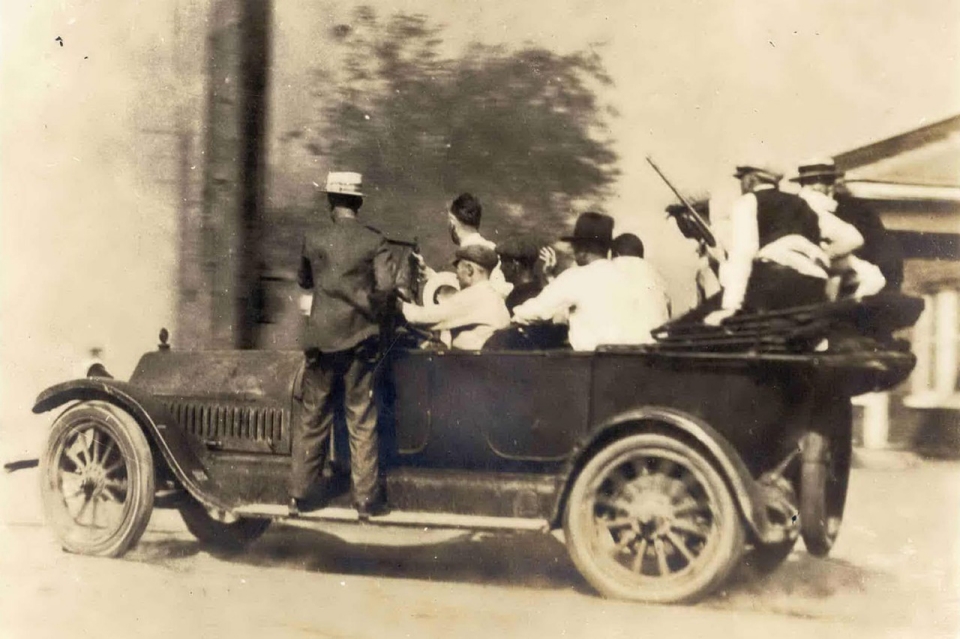
Armed white men ride with a few black men in the car during the riot: photo courtesy of Tulsa Historical Society via Al Jazeera America, 19 July 2014
A group of black men, many of them World War I veterans, armed
themselves and went to the courthouse to protect Rowland, determined
that a black person would not be lynched in their town.
More than 75 of them twice arrived at the courthouse to offer their services to defend Rowland against a mob of thousands of angry whites. They were twice denied. Their departure from the courthouse the second time would be the tipping point.
According to the official report, a white man approached one of the black men, who was armed with a revolver.
“Nigger, what are you going to do with that pistol?” he said.
“I’m going to use it if I need to,” the black man replied.
The white man demanded he hand it over, and he refused. When the white man tried to disarm him, the gun went off and the riot began.
Over the course of 24 hours, Greenwood would be looted, set ablaze and literally burned off the map. All 35 blocks were gone.
When the smoke cleared on June 1, more than $1.5 million in damage (about $20 million in contemporary dollars) had been done; as many as 300 people, black and white, had been killed; and thousands of black families were left homeless, with nothing but rubble and ash to call home.
More than 75 of them twice arrived at the courthouse to offer their services to defend Rowland against a mob of thousands of angry whites. They were twice denied. Their departure from the courthouse the second time would be the tipping point.
According to the official report, a white man approached one of the black men, who was armed with a revolver.
“Nigger, what are you going to do with that pistol?” he said.
“I’m going to use it if I need to,” the black man replied.
The white man demanded he hand it over, and he refused. When the white man tried to disarm him, the gun went off and the riot began.
Over the course of 24 hours, Greenwood would be looted, set ablaze and literally burned off the map. All 35 blocks were gone.
When the smoke cleared on June 1, more than $1.5 million in damage (about $20 million in contemporary dollars) had been done; as many as 300 people, black and white, had been killed; and thousands of black families were left homeless, with nothing but rubble and ash to call home.

The damage to the Williams Dreamland Theatre in Greenwood: photo courtesy of Tulsa Historical Society via Al Jazeera America, 19 July 2014
Even then, there were people who wanted to pay restitution.
According to a 1921 New York Times article,
Judge Loyal J. Martin, a former mayor of Tulsa who chaired the first
race riot committee -- the Tulsa City Commission -- just days after the
attack, said in a mass meeting that the city could redeem itself and
move forward only “by complete restitution and rehabilitation of the
destroyed black belt.”
"The rest of the United States must know that the real citizenship of
Tulsa weeps at this unspeakable crime and will make good the damage, so
far as it can be done, to the last penny,” he said.
But that never happened. Insurance companies denied claims from
African-Americans, leaving them with nothing but the clothes on their
backs, forced to start over or leave. Blacks tried to sue the city and
state for damages but had their claims blocked or denied, according to
the official report.
On June 14, just two weeks after the riot, Mayor T.D. Evans addressed
the commission, telling it that the incident was “inevitable” and that
the victims “should receive such help as we can give them.”
But then he said something else: “Let us immediately get to the
outside fact that everything is quiet in our city, that this menace has
been fully conquered, and that we are going on in a normal condition.”
In other words: The city should move on. And for 90 years, that’s what happened.
After an initial flurry of reports, with articles appearing as far
away as the London Times, news of the “troubles” in Tulsa vanished.

A Tulsa man is detained during the riot: photo courtesy of Tulsa Historical Society via Al Jazeera America, 19 July 2014
Greenwood did rebuild, bigger and better
than it was before. But desegregation claimed Greenwood just as it did
every black town in the United States; given the opportunity to spend
money outside their own neighborhood for the first time, and the chance
to live in areas previously off limits to them, African-Americans slowly
but steadily moved away from the area, and the businesses left with
them.
The Greenwood of today looks nothing like the once famous area. A
highway overpass cuts right through the middle of the neighborhood. The
sidewalks along Greenwood Avenue and Archer Street are lined with
hundreds of plaques that each list the name of a business that was
destroyed in the riot and whether or not it was rebuilt. Many were not.
But just behind the businesses on Greenwood Avenue is a shiny new
baseball stadium, and across the street is a new luxury condominium
building. A large chunk of Greenwood is now home to the Tulsa campuses
of both Oklahoma State University and Langston University.

An armed man during the riot: photo courtesy of Tulsa Historical Society via Al Jazeera America, 19 July 2014
From the time of the riot, whole
generations of Tulsans have grown up never hearing a word about the
darkest moment in the city’s history.
Damario Solomon-Simmons, an African-American attorney in Tulsa, is one of them.
A native of North Tulsa, Solomon-Simmons attended Carver Middle
School -- on Greenwood Avenue -- and still didn’t learn about Greenwood
and the riots until he took an African-American studies course at the
University of Oklahoma.
All of it -- the business district and the homes, the sudden
destruction -- left him flabbergasted. He argued with his professor,
telling him, “You’re wrong! I’m from Tulsa, I’m from North Tulsa, I’ve
never seen or heard of anything like that.’’
Marc Carlson, a historian and archivist at the University of Tulsa
who oversees the school’s race riot collection, said many of his
students don’t know either, not even the ones from Tulsa.
“I don’t know why that is,” he said, adding that the state Legislature requires schools to include the riot in their curriculum.
Oddly, there is more awareness of the event in other countries than in the U.S.
Michelle
Place, executive director of the Tulsa Historical Society, said
requests for information about the riot are the society’s No. 1 inquiry.
"About a month ago I talked to someone in New Zealand. I’ve talked to Tokyo, I’ve talked to London,” said Place.
She can understand why city leaders might be reluctant to put it in
school textbooks. But why, she wondered, didn’t the tale survive orally?
“The fact that it’s not just one of those things that we all knew
took place,” she said and paused, “… takes my breath away, brings me up
short.”
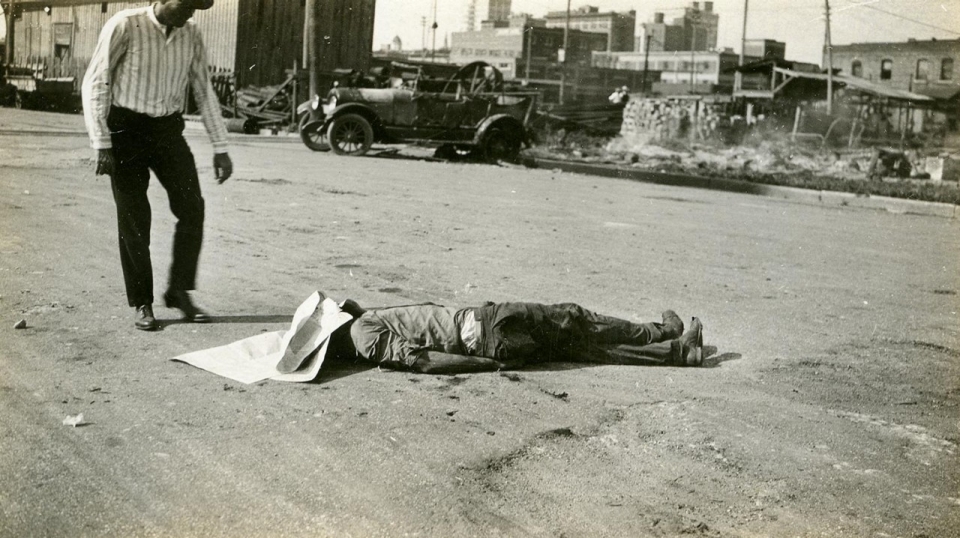
A dead body in the street, June 1, 1921: photo courtesy of Tulsa Historical Society via Al Jazeera America, 19 July 2014
Despite suffering massive losses from the riot, many people in the
black community did not and still do not know about it, said Mechelle
Brown, program coordinator at the Greenwood Cultural Center.
Many whites were ashamed of the incident, she said, so it would make
sense that they wouldn’t want to talk about it. But it was also hushed
up in the black community. Why, she wondered, wouldn’t they want people
to know what happened to them?

Firefighters extinguish the flames during the riot: photo courtesy of Tulsa Historical Society via Al Jazeera America, 19 July 2014
“But blacks, we asked years ago, ‘Why did you not talk about it?’ And
they said that after the race riot, when they came back here and there
was absolutely nothing to come home to, that they felt those same
feelings of anger and resentment and bitterness and fear,” Brown said.
“But they had to think about the next day, and the day after.”
Brown understands why they wouldn’t want to relive that pain, she said. At the same time, she sees it as a missed opportunity.
“It robbed us of something. It robbed us of our history. It robbed us of where we come from.”
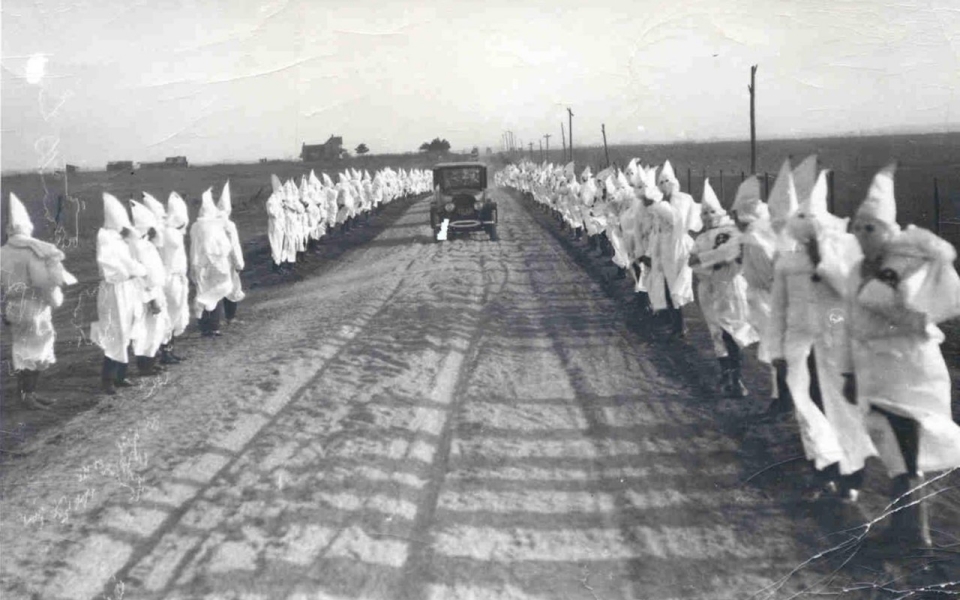
A Ku Klux Klan gathering in Drumright, Oklahoma, 1922. The Klan's presence in Oklahoma increased after the riot: photo courtesy of Tulsa Historical Society via Al Jazeera America, 19 July 2014
In
2001, 80 years after the destruction of Greenwood, the Tulsa Race Riot
Commission recommended in a 178-page report that survivors be paid
reparations, calling it a “moral obligation.”
“Justice demands a closure as it did with Japanese Americans and
Holocaust victims of Germany,” the report reads. The issue is not if
reparations are to be paid, but “which government entity should provide
financial repair to the survivors and the condemned community that
suffered under vigilante violence?”
Paying reparations was just not something Oklahomans were interested in entertaining.
Brown said that almost as soon as word got out about the possibility
of reparations, the Greenwood Cultural Center began to receive hate mail
and angry, anonymous phone calls from people who did not support paying
out. A lot of the calls were similar: “I wasn’t here, my parents
weren’t involved in it.”
The Oklahoma state Legislature accepted the report and the “moral
responsibility on behalf of the state and its citizens” but flatly
refused to pay any type of reparations.
More than 200 people sued the state, seeking recourse for damages.
The survivors weren’t asking for individual checks for themselves or
their descendants; they wanted educational benefits such as scholarships
for students in the area to attend historically black colleges and
universities and health benefits for descendants who remained in
Greenwood.
Unfortunately,
Oklahoma law requires that civil rights lawsuits be filed within two
years of an event, and District Judge James O. Ellison noted that the
clock began ticking right after the riot. The U.S. Supreme Court said
the same.
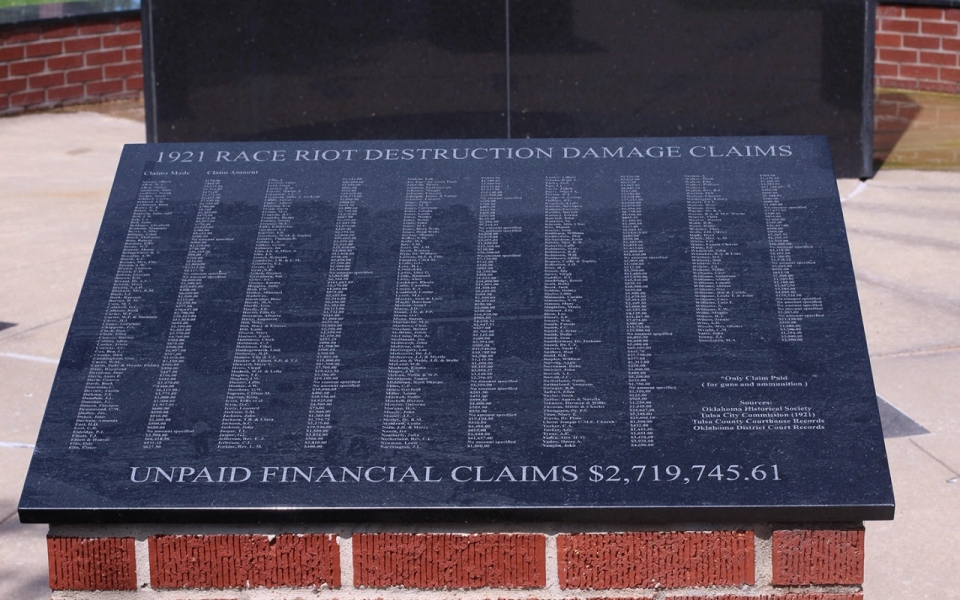
Thousands of families were left homeless from the fire that raged through the 35 blocks of Greenwood during the riot: photo by Dexter Mullins for Al Jazeera America, 19 July 2014
For Solomon-Simmons, an attorney who worked with the victims’ legal
team, having the case denied by the nation’s highest court just added
insult to injury.
“I felt like we were right. We had the facts on our side. I think we
should have had the law on our side,” he said. “I still get exceedingly,
if I’m frank, pissed off, just thinking about the fact that we were not
able to get redress for the survivors and their descendants.”
Tulsa did construct the John Hope Franklin Reconciliation Park
in the middle of Greenwood, a memorial to the destruction and a tribute
to the survivors. It’s one of two monuments in the area -- the other is
in front of the Greenwood Cultural Center and was built with money
raised exclusively by the center several years before the reconciliation
park.

The Mabel B. Little Heritage House, one of the few homes to survive the riot, is maintained by the Greenwood Cultural Center. The home is filled with items typical of a home in 1920s Greenwood: photo by Dexter Mullins for Al Jazeera America, 19 July 2014
Despite articles appearing in publications over the years, most people in the U.S. still have no idea the event
even occurred. There is a major push from the Tulsa Historical Society,
the Greenwood Cultural Center and the University of Tulsa to fix that.
The
historical society has digitized its riot archive and put the
collection onto an app, hoping to satisfy the seemingly unyielding
demand for information about the riot, and to reach new people.
The app launched in May for $9.99, and as more material comes in, it
will update so people can see the latest information. UT is also
digitizing the cultural center’s archives so the information can be
shared online.
The survivors may not have won their case, but at least now people may finally learn about the prosperity they once had.
After they lost their appeals, not much has happened in the way of
paying the few remaining survivors. Old age and time has claimed the
lives of many of them, and more die every year without any restitution.
There are some efforts in Congress to try and help. Rep. John
Conyers, D-Mich., introduces a bill every year on the floor of the House
to remove the statute of limitations in the Greenwood case to allow the
survivors’ lawsuit to go forward.
But that bill -- along with the one
Conyers presents each year to study reparations for slavery -- is not
likely to ever get further than that introduction, especially in today’s
divided Congress.
“We thought we might live long enough to see something happen, but
even though I’ve lived 99 years, nothing of that sort has actually
happened,” Hooker said. “You keep hoping, you keep hope alive, so to
speak.”
After all, it did take 80 years before the survivors of the riot even
got an official apology from the city of Tulsa. Mayor Kathy Taylor held a “celebration of conscience” and honored with a medal each of the survivors the city could contact.
But Hooker,who was the first African American woman to serve in the
Coast Guard and went on to earn a doctorate's in psychology, remains
optimistic.
“We’ll just keep right on trying, never giving up. Never, never giving up.”
Solomon-Simmons, on the other hand, isn’t nearly as hopeful.
The collective failure to act, to pay the victims, to set up a
scholarship fund or make a real attempt at restitution is a “stain on
our nation,” he said.
“And it’s sad to know that they’re probably all going to die without
receiving anything,” he added. “Unfortunately, black life in America is
still not worth that much.”

Sculptor Ed Dwight created three statues to convey the hostility, humiliation and hope experienced by the Greenwood neighborhood. Found in the John Hope Franklin Reconciliation Park, this statue represents humiliation: photo by Dexter Mullins for Al Jazeera America, 19 July 2014

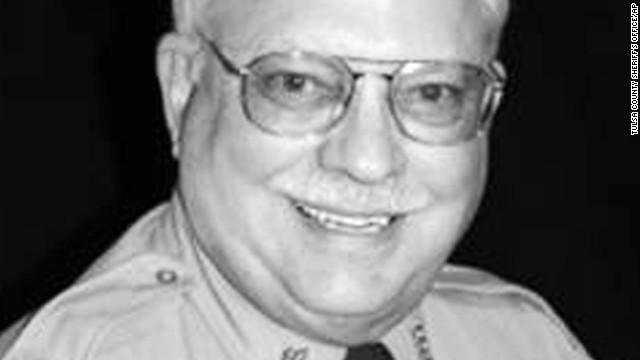
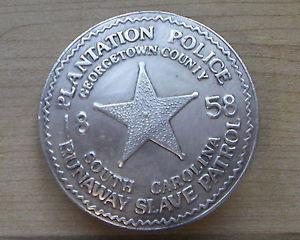
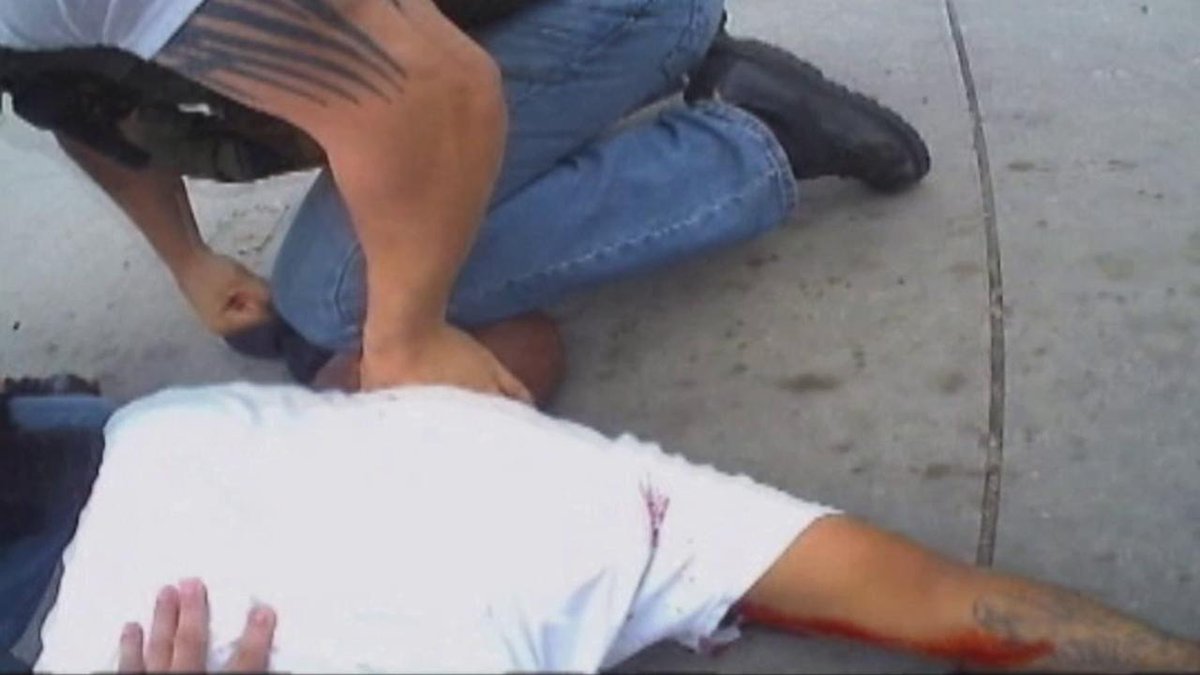
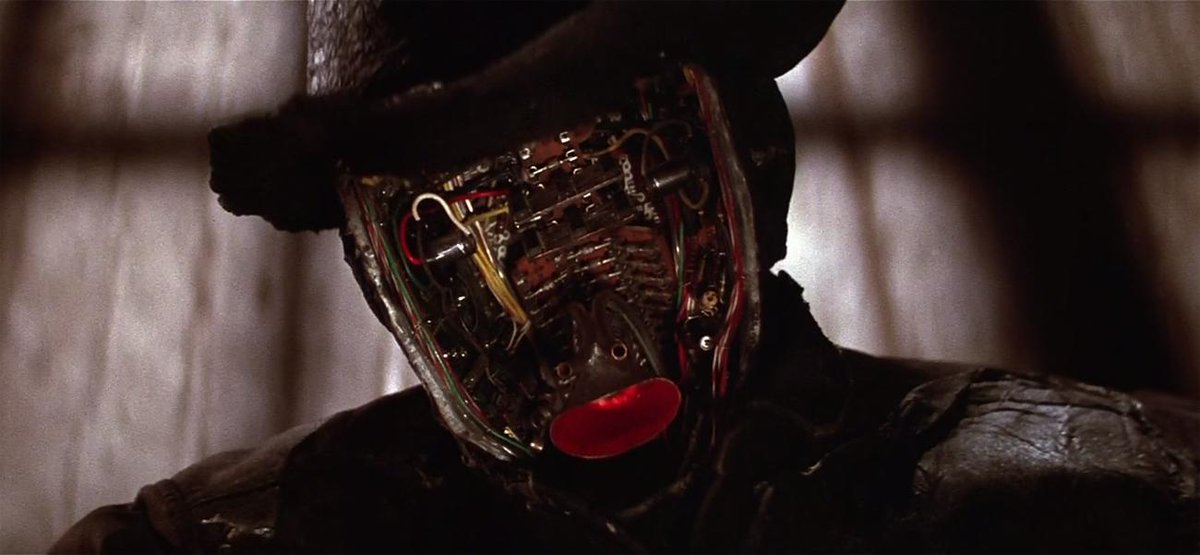


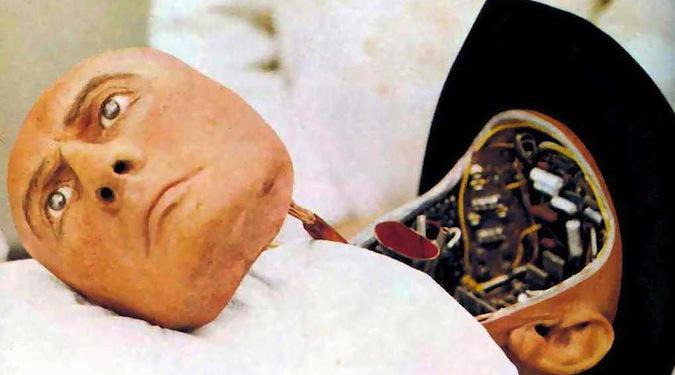
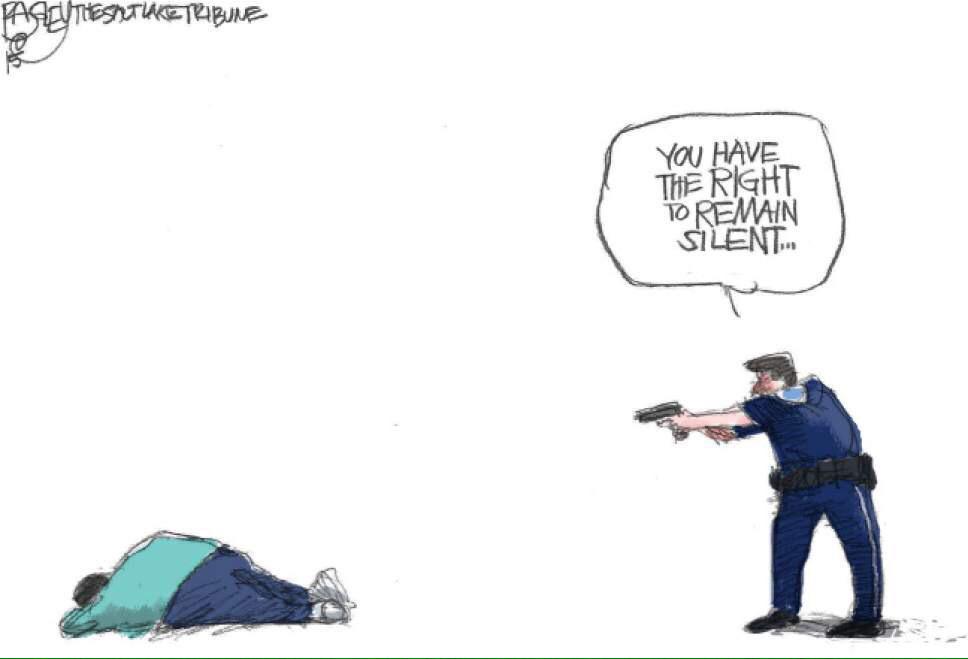




3 comments:
.
.
.
.
.
guess I should donate
something to the police
like a soul
since I'm not using mine
but wait
I can't seem to find it
.
.
.
.
Oklahoma! ("Plenty of room to swing a rope...")
Tulsa, OK Cops Kill Unarmed Black Man Shooting Him In The Back: "In America, a dog is worth more than Eric Harris"
RUNAWAY SLAVE PATROL?
Post a Comment